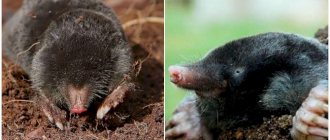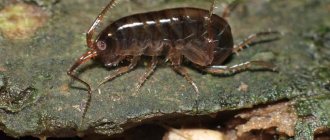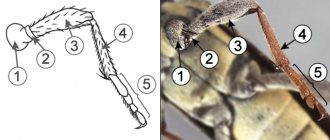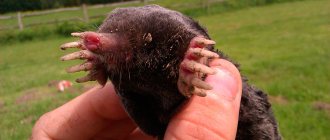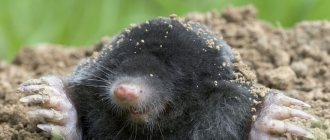Contrary to popular belief that the mole is blind and has no organs of vision, the animal has eyes and even sees poorly. In almost all populations of the European mole, the organ of vision can be seen if the fur is parted. The palpebral fissures are so small that this cannot always be done right away, especially if you look for them in a dead animal. In this case, the person who found the animal’s body doubts whether the mole has eyes. In some varieties of the European mole, during the process of evolution, the palpebral fissures have grown together, but they still have eyes.
Mole Spread
A mole is a mammal of the order of insectivores. The habitat of the common mole is very widespread . It can be found in almost all regions of the Russian Federation, Ukraine and Belarus.
It lives in dry meadows, forests with deciduous shrubs and birch trees.
most often found on forest edges , slopes of railway tracks, thawed areas, clearings, forest clearings and roads that are well lit by the sun .
It can cause irreparable damage to a garden in a country house, garden, greenhouses, parks, and arable land with cereal crops. The mole does not like continuous forest plantings of coniferous trees, hills with sandy soil, swampy areas, and floodplain meadows.
Does not like soil on which shrubs or trees with a powerful root system . It prefers humus black soil with moderate humidity .
In such soil you can find insects, larvae and worms. The chosen location depends on the temperature factor.
The stronger the temperature changes , the closer the animal gets to the forest.
Moving from the lowlands to the top, moles find the most favorable and sun-warmed habitats.
Important! If the ground freezes and crusts over in winter, the animal may become trapped. Moles often die in winter due to harsh weather and lack of food, since they are found only in the upper layers of the soil. At this time, earthworms and insects descend into the deepest soil horizons.
Do moles have eyes and why do people think they don’t have them?
In fact, the mole has eyes. In an ordinary European species, they are easy to see if you take the animal and spread the fur just above the nose, between the bridge of the nose and the place where the ears are supposed to be located (by the way, they are also not visible on a mole). Here tiny slits are found in the skin among the fur, and already under them are, in fact, the eyes.
If there is a live animal in your hand, then in most cases its eyes will be open and, pardon the pun, they will be visible to the naked eye.
On a note
In some species of moles, as well as in some geographic populations of the European mole, the eyelids are fused and the eyes are permanently located under the skin. But at the same time, the eyes themselves exist and do not disappear anywhere.
At the same time, if you don’t purposefully look for the animal’s tiny eyelids, then it can be difficult to notice them. It is not surprising that many gardeners, having caught an animal on the plot, take a quick look at it and do not find eyes (and also do not find ears). Usually the gardener ends up with a cold corpse in his hands, and therefore the conclusion is quickly drawn that the mole has no eyes at all, and the former garden pest is thrown out onto the compost heap.
By the way, you also need to take into account the fact that the authority of the gardeners themselves, who actually held in their hands, albeit dead, but real moles, is often higher among ordinary people than, say, the authority of an armchair scientist who is considered a “bookworm.” The argument “I caught hundreds of these moles and held them in my hands, but never saw the eyes of a single one” sounds more convincing to the average citizen than “science has proven...”. And therefore, the opinion that moles do not have eyes is quite widespread, although with some effectiveness it is eradicated from young shoots even at school.
So, we have established that the mole does have eyes. You can even see them in the photo below:
Therefore, it is not correct to talk about the complete disappearance of the mole’s eyes. At least it's a little premature.
A little lower we will talk about the fact that at the moment, apparently, the evolutionary disappearance of eyes in moles is occurring. This process is a form of natural selection that ensures the greatest adaptability of animals to their living conditions.
But before we delve into the jungle of evolution, let's first try to look at the world through the eyes of a mole...
Lifestyle
This mammal is a solitary animal. When meeting another male, a fight ensues, which lasts until the death of one of the moles . After this, it ends in cannibalism.
The mole leads an underground lifestyle throughout its entire life The diameter of the burrows is 4-6 cm. Residential passages lead from the main nest to a watering hole.
The source of water is rivers, puddles, drains, ponds, lakes, ditches, swamps. For hunting, the mole digs feeding tunnels. In 24 hours it can dig 10-20 m .
The nest is covered with forest moss or thick grass. The total length of the burrows is 1.0-1.5 km .
Burrow construction
The mole spends most of its life underground. Only to develop a new area does it come to the surface. The animal digs two types of tunnels:
- veins;
- search engines
The first ones are also called nests; the mammal rests and hides in them during the cold season. They lie at a depth of 10−90 cm, and their diameter is only 5 cm. Closer to the surface, the mole makes search passages. He digs them so that earthworms and other underground invertebrates live nearby. The network is extensive, it can occupy significant areas - hundreds of square meters. Moles leave traces behind them: soil rollers that appear due to the swollen arches of passages.
The animal digs the ground with its front paws, and rests against the already compacted walls of the hole with its hind paws. At a depth of 10 cm, the mammal can no longer raise its head, so it throws the soil to the surface.
These heaps are called molehills; they reach 15–25 cm in height and up to 1 m in diameter. They are usually gathered in small groups. Molehills are the only sign of the presence of moles on the site that a person can detect.
Photo
If you don’t know what a mole looks like, then a photo of the animal will clearly show you what it looks like:
Exposure to weather conditions
The main climatic enemies that affect the life expectancy of moles are:
- Drought that destroys vegetation, causing the death of invertebrates and other insects on which they feed.
- Frosts, or rather, freezing of the soil. If the soil becomes too hard, moles lose the ability to move because they cannot dig. And the food in their pantries can freeze and become inedible.
- Floods caused by rivers overflowing due to heavy and frequent rainfall or large amounts of ice and snow. Flooded burrows force animals to rise to the surface, and if they do not drown, they often become victims of land-based predators.
It is because of such “cataclysms” (on the scale of moles) that their average life expectancy is 3-4 years.
Description of the animal
Its cylindrical, shortened, dense body helps it move through dug tunnels . It is slightly pointed at the front and rounded at the back.
The front part is much better developed. The animal has 6 main species and 11 different varieties. They differ in the structure of the jaw, skeleton, their weight, and size.
Young individuals differ from older mammals in the silvery hue of their skin. The mole has practically no neck. The head seems pulled into the shoulders.
The body smoothly touches the triangular shaped head . On the head there is a proboscis, along the edges of which there are vibrissae. Thanks to these sensitive hairs, the animal finds food.
The mole's forelimbs are wide, everted, and shaped like a spade . Initially the paws are silver-black. Over time they begin to fade.
There are 5 tightly pressed toes on the feet. They are connected by thin membranes. The claws are elongated, strong, slightly flattened. They reach 10 mm in length.
The hind feet are unwebbed, but with very sharp, elongated claws. The animal has 44 teeth , 2 of which are well-developed upper canines. In adult moles, the fangs are severely worn out.
The size of a male mole from proboscis to tail can reach 115-200 mm , females - from 105 to 145 mm. The weight of males is 90-100 g, females - 60-80 g.
Habitat
How long a mole lives often depends on its habitat. We do not mean specific regions here, since this mammal is distributed everywhere, with the exception of the polar regions and countries with cold or too hot climates.
An important criterion for the habitat of these animals is the looseness of the soil and the abundance of invertebrates in it, which they feed on. This is why moles prefer:
- Clearings in the forest where there are no trees with their powerful rhizomes.
- Meadows in which forbs loosen the soil with their roots and fertilize it, attracting a large number of different larvae and earthworms.
- Broad-leaved and mixed young forests in which moles find attractive edges.
- Farmland where the soil is constantly loosened and cultivated.
- Hilly and mountainous terrain up to the alpine meadow zone.
If nothing disturbs the peace of moles in these places, then they can live up to 7 years.
Sense organs
The eyes are small, very poorly developed and almost completely covered with skin. The mole has no ears .
The auditory openings are also covered with skin. But the animal’s hearing is remarkably developed.
Which sense organs are better developed in a mole? The frequency sound conductivity of the soil is available to him . The sense of smell is well developed. By smell, he finds food in the ground.
Tactile hairs are distributed throughout the body. Thanks to them, he senses worms located 50-70 cm from him .
Also an integral part is a 2-centimeter tail, which is covered with hairs. When the mole lifts its tail up, it feels the ceiling of the dug tunnel . If he does not feel the ground, he returns to his hole.
Living environment and lifestyle
Well, we won’t be original here. Everyone has seen mole holes on the ground, and therefore it is easy to conclude that the mole’s habitat is soil. If we see such small mounds of earth in a meadow, there is no doubt that the burrower lives in the depths of the lawn.
Animals prefer to live in moist, loose soil. Such soil is easier to dig, and, of course, this digger always tries to find such an underground environment convenient for living.
However, in the absence of this, the animal does not lose heart, and is quite capable of living in a denser soil environment, it’s just that in this case the length of the tunnels it digs is not so great.
If the soil is what it needs, a blind mole is able to dig through fairly long underground passages, dotting the surface of the earth with molehills, that is, holes for oxygen to enter the burrow system, as well as for throwing away excess building material (soil).
Mole burrows can extend for hundreds of meters, and such underground passages dug by moles are complex labyrinths looped into a single system.
Nutrition
The mammal feeds only on animal food . The main food is earthworms and small insects and vertebrates.
Help: In the wild, moles can feed on mice, rats, frogs, and ants.
The metabolism of this mammal is very fast. Therefore, the mole has to absorb a lot of food . During the day, the animal eats food equal to its own weight. To live, males need 145 grams of food, females – 80 grams.
If the animal is hungry, it can eat on the surface of the soil. But in most cases, moles take their prey into dug holes . The animal's stomach can hold 20 grams of food.
In 30 minutes, a mammal can eat 35-45 grams of earthworms. After 5-6 hours, the mole eats the same amount of food. After this, he goes into hibernation for 3-4 hours , after which the search for food begins again.
Important! Plant food is not food for moles. If plant particles get inside, they end up there randomly or from the digestive tract of earthworms.
Several factors influence how many years a mole lives:
- Diseases and attacks of pests and insects;
- Living conditions, temperature changes, soil freezing;
- Meeting with enemies - fox, marten, eagle owl;
- Cannibalism between one subspecies;
- Nutrition, hunger strike, food shortage.
How long does the common mole live under favorable conditions? The average lifespan of an animal is 4-7 years.
Find out in our articles what harm the mole causes to the farm and methods of combating it.
The mole is an insectivorous animal. The life of a mole passes in holes on the edges of the forest, in garden plots, clearings and roads. The weight reaches 100 grams.
During the day he eats food equal to his own weight. It hides its nests from people, predators and other males. Under good conditions it can live 7 years .
Lifestyle of underground inhabitants
It is probably easier to list the places where moles do not live, since these mammals are distributed almost everywhere. They are only found where the soil is not suitable for them due to its density or composition. So, they don't like:
- Sandstones and too dry places where it is difficult to get food.
- Tundra and forest-tundra due to too deep freezing of the ground.
- Places where groundwater is close to the surface.
- Forests overgrown with powerful trees and shrubs, whose root system is intertwined into a single dense “carpet”.
Moles prefer soft soil, which makes it easy to dig underground tunnels. They often choose vegetable gardens in their summer cottages and garden plots as their home, since the soil there is constantly loosened and fertilized, which leads to an increase in the number of worms and insects that they feed on.
Read also
Mole It was once believed, and many still think so, that moles are blind. But the mole has eyes - small beads covered with fur and skin. With these eyes the mole sees, but very
Mole It was once believed, and many still think so, that moles are blind. But the mole has eyes - small beads covered with fur and skin. With these eyes the mole sees, but very
Can a cat see in the dark?
Can a cat see in the dark? Perhaps you have a cat living at home. You love to hold your pet in your arms, play with her and feel that she is almost a member of the family. But a cat is one of the strangest creatures on earth. Despite the fact that she has been tamed and lives with people already
Why can't humans see infrared rays?
Why can't humans see infrared rays? (Asked by Martin Langford, Peakhurst, New South Wales, Australia) This is a very interesting question. According to Dr. Tom Stickel8, the human eye is capable of detecting electromagnetic radiation with wavelengths from 380 to 700
Which animal can see with its ears?
Which animal can see with its ears? Bats see with their ears, not their eyes. Although they are not blind, they see very poorly. We know that bats can tell the difference between day and night, but we don't know if they can tell the difference between objects. One day, scientists conducted special experiments. IN
Mole It was once believed, and many still think so, that moles are blind. But the mole has eyes - small beads covered with fur and skin. With these eyes the mole sees, but very
Can an owl see at night?
Can an owl see at night? For thousands of years, the owl has been a creature of special significance to humans. Primitive people had many prejudices regarding owls, mainly because of the unique calls that they make. In many European countries
Mole The mole is a small animal, a maximum of fifteen centimeters in length, with a flat body, a pointed muzzle resembling a proboscis, short, soft fur, often black. The most unusual thing about a mole is its front paws. They are turned “palms” to the sides and
Mole Mole (Talpa) is a genus of insectivores from the mole family (Talpidae). On the extremely sensitive muzzle, extended into a proboscis, the nostrils lie below; the mouth is armed with 44 teeth: in the upper jaw on each side there are 3 small anterior ones, 1 fang-shaped and 7 molars, in the lower jaw there are 4
Why in England can the owner of a two million pound house have an old cheap car, while in Russia a person may not have a house, but will have a Porsche?
Why in England can the owner of a two million pound house have an old cheap car, while in Russia a person may not have a house, but will have a Porsche? DMITRY GOLOLOBOVDirector of Gololobov and Co (London), former head of the legal department of YUKOSIn fact, the reasons for this
Seeing the speck in someone else's eye and not seeing the log in your own
Seeing the speck in someone else's eye and not seeing the beam in your own From the Bible. New Testament, Gospel of Matthew (chapter 7, v. 3): “And why do you look at the speck in your brother’s eye, but do not feel the beam in your own eye?” Also Art. 5: “Hypocrite! First take the beam out of your eye, and then you will see how
Mole of history
Mole of History The expression is based on an image from the tragedy “Hamlet” by William Shakespeare (1564-1616) (act 1, scene 5). Hamlet, hearing the voice of his late father coming from underground, exclaims (translation by A.L. Sokolovsky): You dig well, old mole! You're fit to be a miner. Thanks to
Fall asleep and dream...
Falling asleep and dreaming... Sleep is a process that appeared at a fairly early stage of evolutionary development. For most animals, constant activity 24 hours a day is very rare. Something like sleep is observed even among many sea fish: they
Source
